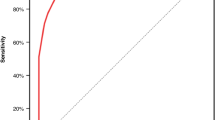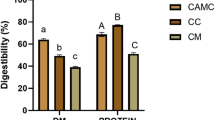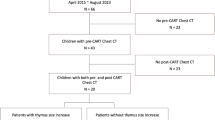Abstract
Background:
This study aimed to investigate the role of the effectiveness of camel milk (CM) (raw and boiled) on thymus and activation-regulated chemokine (TARC) serum levels and childhood autism rating scale (CARS) score in subjects with autism and compared to placebo group (cow milk).
Methods:
Forty-five subjects diagnosed with autism were randomly assigned to receive boiled CM for group I (n = 15), raw CM for group II (n = 15), and placebo for group III (n = 15) for 2 wk. Measures included changes in professionally completed CARS score and blood samples for TARC serum level were taken before and after milk consumption of 500 ml per day in children’s regular daily diet.
Results:
The serum levels of TARC decreased significantly (P = 0.004) in boiled CM and in raw CM group (P = 0.01) too, but no effect was observed (P = 0.68) in placebo group. Furthermore, significant improvements were observed in CARS score (P = 0.04) in raw CM group only. There were no significant relationships between the serum of TARC level and the CARS score, age, or gender for any group.
Conclusion:
CM administered for 2 wk significantly improved clinical measurements of autism severity and decreased serum level of TARC in autistic children, but subsequent studies are recommended.
Similar content being viewed by others
Log in or create a free account to read this content
Gain free access to this article, as well as selected content from this journal and more on nature.com
or
References
Baird G, Simonoff E, Pickles A, et al. Prevalence of disorders of the autism spectrum in a population cohort of children in South Thames: the Special Needs and Autism Project (SNAP). Lancet 2006;368:210–5.
American Psychiatric Association. Diagnostic and Statistical Manual of Mental Disorders, 4th edn, Text Revision. Washington, DC, American Psychiatric Association, 2000.
Hollander E, Phillips A, King BH, et al. Impact of recent findings on study design of future autism clinical trials. CNS Spectr 2004;9:49–56.
Ivarsson SA, Bjerre I, Vegfors P, Ahlfors K . Autism as one of several disabilities in two children with congenital cytomegalovirus infection. Neuropediatrics 1990;21:102–3.
Edelson SB, Cantor DS . The neurotoxic etiology of the autistic spectrum disorder: A replicative study. Toxicol Ind Health 2000;16:239–47.
Fatemi SH, Earle J, Kanodia R, et al. Prenatal viral infection leads to pyramidal cell atrophy and macrocephaly in adulthood: implications for genesis of autism and schizophrenia. Cell Mol Neurobiol 2002;22:25–33.
Al-Ayadhi LY, Mostafa GA . Low plasma progranulin levels in children with autism. J Neuroinflammation 2011;8:111.
Al-Ayadhi LY, Mostafa GA . A lack of association between elevated serum levels of S100B protein and autoimmunity in autistic children. J Neuroinflammation 2012;9:54.
Gerlai J, Gerlai R . Autism: a large unmet medical need and a complex research problem. Physiol Behav 2003;79:461–70.
Plioplys AV . Intravenous immunoglobulin treatment of children with autism. J Child Neurol 1998;13:79–82.
Ashwood P, Wills S, Van de Water J . The immune response in autism: a new frontier for autism research. J Leukoc Biol 2006;80:1–15.
Cohly HH, Panja A . Immunological findings in autism. Int Rev Neurobiol 2005;71:317–41.
Agrawal RP, Jain S, Shah S, Chopra A, Agarwal V . Effect of camel milk on glycemic control and insulin requirement in patients with type 1 diabetes: 2-years randomized controlled trial. Eur J Clin Nutr 2011;65:1048–52.
Mohamad RH, Zekry ZK, Al-Mehdar HA, et al. Camel milk as an adjuvant therapy for the treatment of type 1 diabetes: verification of a traditional ethnomedical practice. J Med Food 2009;12:461–5.
Saltanat H, Li H, Xu Y, Wang J, Liu F, Geng XH . [The influences of camel milk on the immune response of chronic hepatitis B patients]. Xi Bao Yu Fen Zi Mian Yi Xue Za Zhi 2009;25:431–3.
Kushak RI, Lauwers GY, Winter HS, Buie TM . Intestinal disaccharidase activity in patients with autism: effect of age, gender, and intestinal inflammation. Autism 2011;15:285–94.
Shabo Y, Barzel R, Margoulis M, Yagil R . Camel milk for food allergies in children. Isr Med Assoc J 2005;7:796–8.
Shabo Y, Yagil R . Etiology of autism and camel milk as therapy. Int J Dis Human Dev 2005;4:67–70.
Borish LC, Steinke JW . 2. Cytokines and chemokines. J Allergy Clin Immunol 2003;111:Suppl 2:S460–75.
Kappeler S, Farah Z, Puhan Z . Sequence analysis of Camelus dromedarius milk caseins. J Dairy Res 1998;65:209–22.
Beg OU, von Bahr-Lindström H, Zaidi ZH, Jörnvall H . Characterization of a camel milk protein rich in proline identifies a new beta-casein fragment. Regul Pept 1986;15:55–61.
Makinen-Kijunen S, Palosne T . A sensitive enzyme-linked immunosorbent assay for determination of bovine beta-lactoglobulin in infant feeding formulas and human milk. Allergy 1992;47:347–52.
Restani P, Gaiaschi A, Plebani A, et al. Cross-reactivity between milk proteins from different animal species. Clin Exp Allergy 1999;29:997–1004.
Kunkel EJ, Boisvert J, Murphy K, et al. Expression of the chemokine receptors CCR4, CCR5, and CXCR3 by human tissue-infiltrating lymphocytes. Am J Pathol 2002;160:347–55.
Bhowmick S, Chatterjee D, Chaudhuri K . Human epithelial cells stimulated with Vibrio cholerae produce thymic stromal lymphopoietin and promote dendritic cell-mediated inflammatory Th2 response. Int J Biochem Cell Biol 2012;44:1779–90.
Oliphant CJ, Barlow JL, McKenzie AN . Insights into the initiation of type 2 immune responses. Immunology 2011;134:378–85.
Machura E, Rusek-Zychma M, Jachimowicz M, Wrzask M, Mazur B, Kasperska-Zajac A . Serum TARC and CTACK concentrations in children with atopic dermatitis, allergic asthma, and urticaria. Pediatr Allergy Immunol 2012;23:278–84.
Abelius MS, Ernerudh J, Berg G, Matthiesen L, Nilsson LJ, Jenmalm MC . High cord blood levels of the T-helper 2-associated chemokines CCL17 and CCL22 precede allergy development during the first 6 years of life. Pediatr Res 2011;70:495–500.
Karpus WJ, Fife BT, Kennedy KJ . Immunoneutralization of chemokines for the prevention and treatment of central nervous system autoimmune disease. Methods 2003;29:362–8.
Karpus WJ, Ransohoff RM . Chemokine regulation of experimental autoimmune encephalomyelitis: temporal and spatial expression patterns govern disease pathogenesis. J Immunol 1998;161:2667–71.
Ashwood P, Enstrom A, Krakowiak P, et al. Decreased transforming growth factor beta1 in autism: a potential link between immune dysregulation and impairment in clinical behavioral outcomes. J Neuroimmunol 2008;204:149–53.
Rellini E, Tortolani D, Trillo S, Carbone S, Montecchi F . Childhood Autism Rating Scale (CARS) and Autism Behavior Checklist (ABC) correspondence and conflicts with DSM-IV criteria in diagnosis of autism. J Autism Dev Disord 2004;34:703–8.
Hamers-Casterman C, Atarhouch T, Muyldermans S, et al. Naturally occurring antibodies devoid of light chains. Nature 1993;363:446–8.
Al-Gadani Y, El-Ansary A, Attas O, Al-Ayadhi L . Metabolic biomarkers related to oxidative stress and antioxidant status in Saudi autistic children. Clin Biochem 2009;42:1032–40.
Frustaci A, Neri M, Cesario A, et al. Oxidative stress-related biomarkers in autism: systematic review and meta-analyses. Free Radic Biol Med 2012;52:2128–41.
Rose S, Melnyk S, Pavliv O, et al. Evidence of oxidative damage and inflammation associated with low glutathione redox status in the autism brain. Transl Psychiatry 2012;2:e134.
Grigorenko EL, Han SS, Yrigollen CM, et al. Macrophage migration inhibitory factor and autism spectrum disorders. Pediatrics 2008;122:e438–45.
Biber K, Vinet J, Boddeke HW . Neuron-microglia signaling: chemokines as versatile messengers. J Neuroimmunol 2008;198:69–74.
Patterson PH . Immune involvement in schizophrenia and autism: etiology, pathology and animal models. Behav Brain Res 2009;204:313–21.
Oosterling I, Roos S, de Bildt A, et al. Improved diagnostic validity of the ADOS revised algorithms: a replication study in an independent sample. J Autism Dev Disord 2010;40:689–703.
Chlebowski C, Green JA, Barton ML, Fein D . Using the childhood autism rating scale to diagnose autism spectrum disorders. J Autism Dev Disord 2010;40:787–99.
Schopler E, Reichler RJ, Renner BR . The Childhood Autism Rating Scale. Los Angeles, CA, Western Psychological Services, 1994:90025–1251.
Mostafa GA, Al-Ayadhi LY . The relationship between the increased frequency of serum antineuronal antibodies and the severity of autism in children. Eur J Paediatr Neurol 2012;16:464–8.
Eberlein V . Hygienic Status of Camel Milk in Dubai (United Arab Emirates) Under Two Different Milking Management Systems. München, Germany, Maximilians-Universität München, 2007. (http://urn:nbn:de:bvb.)
Elagamy I . Effect of heat treatment on camel milk proteins with respect to antimicrobial factors: a comparison with cows’ and buffalo milk proteins. Food Chemistry 2000;68:227–32.
Acknowledgements
The authors thank Rana Zeina and Zakia Mohammed for their administrative help.
Author information
Authors and Affiliations
Corresponding author
Rights and permissions
About this article
Cite this article
Bashir, S., Al-Ayadhi, L. Effect of camel milk on thymus and activation-regulated chemokine in autistic children: double-blind study. Pediatr Res 75, 559–563 (2014). https://doi.org/10.1038/pr.2013.248
Received:
Accepted:
Published:
Issue date:
DOI: https://doi.org/10.1038/pr.2013.248
This article is cited by
-
Immune Abnormalities in Autism Spectrum Disorder—Could They Hold Promise for Causative Treatment?
Molecular Neurobiology (2018)



